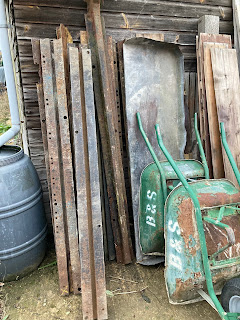As noted in the last posting, following the rediscovery of milepost 7¼ the new head intended for this has duly become that for 7¾ with the addition of two pairs of extra quarter marks. Another bonus of the rediscovery is that we now need one less length of bridge rail; we are now only 18 lengths short!
 |
| The new 7¾ head ready for installation, complete with cap. Interestingly the old BR yellow 7¾ is also in the workshop; so with the one on the line we currently have three 7¾s. But not for long. |
Tuesday 14 December
Another week with two working days for the Drainage team to accommodate member's other commitments.
The Tuesday gang this time numbered just three, but that was the ideal number for clearing drains, clearing access to culverts and undertaking the internal visual inspections. Two on brushcutters, one on a rake or shovel. Each year we inspect all the small cross drains plus all the culverts other than those which the external inspectors cover. Anyway, that is the plan, we are still catching up with the backlog caused by the 2020 and 2021 COVID-19 lockdowns. Today the team progressed from Culvert 20C at Chicken Curve north to Pipe 16A near Didbrook No2 bridge. A total of 8 structures. Helpful that a couple of culverts and cross drains are located close to bridges which were still clear of vegetation following the earlier clearance for the bridge inspections.
 |
| Down side inlet of Culvert 20C, cleared of extensive growth of brook lime, but the water here was very murky. |
 |
| Down side of Cross Pipe 16B, in need of a touch of repointing of the blue brick courses, probably these are original GWR of 1900 vintage |
An unusual find
located by the up side boundary fence at Didbrook was an old coffee
table. As it a very sturdy construction, we though it was too good to
go in the skip. It is now drying out at Winchcombe, any offers of a
good home are welcome.
 |
| The Recovered coffee table. |
Thursday 16 December
The other four members of the team were today’s squad. First task was a quick inspection at Dixton Cutting, to see what remedial work is required following the track relaying activities of the Permanent Way department. Then it was up to Laverton to undertake the clearance and internal visual inspections from Cross Drain 6A northwards. The intention was to complete all the way to Broadway – but thick growth on those at Little Buckland thwarted that. Hence the 'score' for today was 6 structures. Thus Culverts 3A and 3B at Peasebrook will be first on the list for next year, and then we have everything south of Gretton to undertake.
 |
| Looking through the bore of Culvert 4A from the down side. Picture by Dave. |
 |
| Head and wing walls of culvert 5B up side outlet. Most, but not all, of the culverts on this section are all blue brick.Picture by Dave. |
 |
| But not all outlets have headwalls. This is 5C, extended at some point in the past using stone gabions. Picture by Dave. |
Thursday 23 December
Our final workday for the year! Or rather a half-day as we retired in early afternoon to enjoy a Christmas lunch in the Pheasant at Toddington.
Five of the team spent the morning working in the old C&M workshop at Toddington, at times it was a little like Santa's workshop. Particularly as Winchcombe station had become the North Pole for the Santa trains.
First job was to use some strong sealant to join the twinwall extension pipe and coupler for the 24B Haul Road outlet at Working Lane. Doing this in the dry should make for a watertight joint.
 |
| Twinwall pipe and coupler joined, another use for concrete blocks as a weight whilst drying. |
All the other tasks (except one) were related to mileposts. The cast lead numbers were drilled and fettled; then primed. Some which had been previously primed as a homework task received the first coat of black paint. Also painted black were the few remaining cast iron original numerals we have. The steel bar strips for the horizontal dividers and quarter marks (and for some of the number '1's) were primed. From a sheet of galvanised steel and a smaller sheet of aluminium five caps for the heads were made. As usual the first one took twice as long as the rest. These are made to fit each head, as we have two type of head which have slightly different dimensions.
 |
| Dave in charge of painting. |
 |
| Polly cutting and bending the first cap from the galvanised sheet. |
 |
| Jonathan metal bashing another cap. |
 |
| Martin fettling some of the cast numbers. |
 |
| Here are today's numbers! The old BR 7¾ head in the background. |
And finally our most unusual task of the year. A lock on one of the toilet doors in the Tim Mitchell Building had become jammed, trapping a female elf inside. So off went our St. George clasping hammer, screwdriver, pilers and assorted other tools. On his return we had the message 'task successfully completed' but not quite the full details of how the broken lock was unlocked from the outside with out damaging the door. Relief all round! No pictures though.
That is it for another year
With the team taking a well earned break next week, it will be 2022 when we resume. So we send all our readers Season Greetings and wish you all peace, prosperity and happiness for the New Year.














